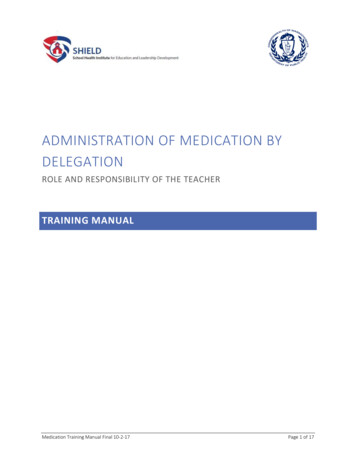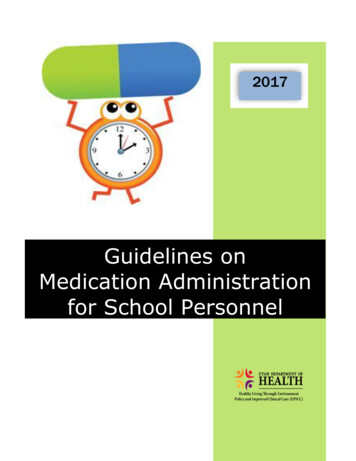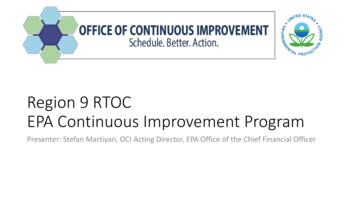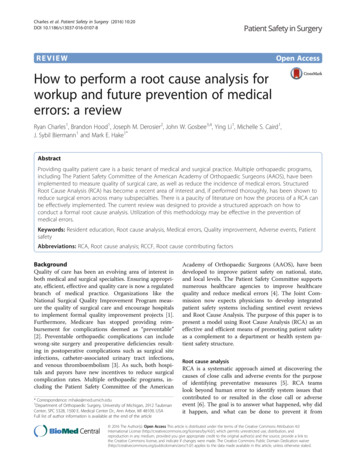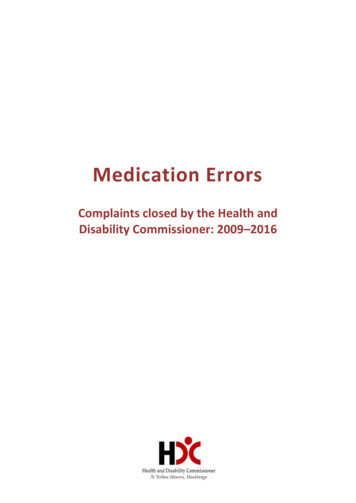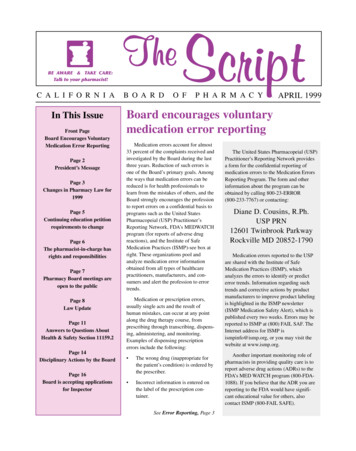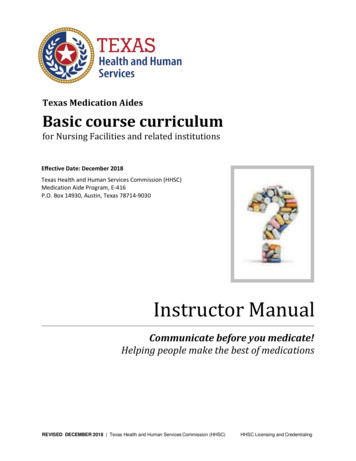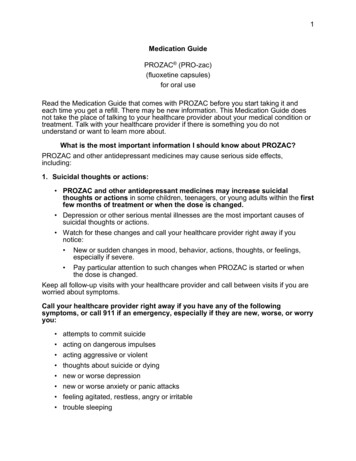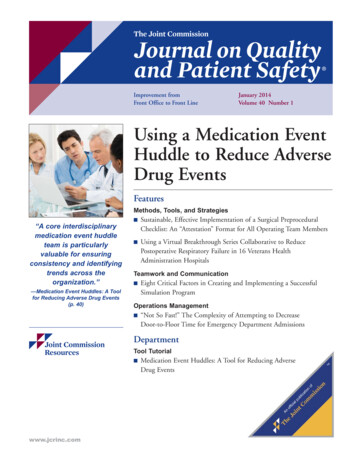
Transcription
Improvement fromFront Office to Front LineJanuary 2014Volume 40 Number 1Using a Medication EventHuddle to Reduce AdverseDrug EventsFeaturesMethods, Tools, and Strategies“A core interdisciplinarymedication event huddleteam is particularlyvaluable for ensuringconsistency and identifyingtrends across theorganization.”—Medication Event Huddles: A Toolfor Reducing Adverse Drug Events(p. 40) Sustainable, Effective Implementation of a Surgical PreproceduralChecklist: An “Attestation” Format for All Operating Team Members Using a Virtual Breakthrough Series Collaborative to ReducePostoperative Respiratory Failure in 16 Veterans HealthAdministration HospitalsTeamwork and Communication Eight Critical Factors in Creating and Implementing a SuccessfulSimulation ProgramOperations Management “Not So Fast!” The Complexity of Attempting to DecreaseDoor-to-Floor Time for Emergency Department AdmissionsDepartmentTool Tutorial www.jcrinc.comMedication Event Huddles: A Tool for Reducing AdverseDrug Events
The Joint Commission Journal on Quality and Patient SafetyTool TutorialMedication Event Huddles: A Tool for Reducing Adverse DrugEventsReaders may submit Tool Tutorial inquiries and submissions to Steven Berman, sberman@jcrinc.com. Sommer Alexander, MS, serves as Tool Tutorial editor.Shelly Morvay, PharmD; Dorcas Lewe, RN, MS; Barbara Stewart, RN, BS; Charline Catt, RN, MS; Richard E. McClead, Jr,MD; Richard J. Brilli, MDIn fall 2008 the leadership of Nationwide Children’s Hospital(NCH; Columbus, Ohio) embarked on a major initiative toeliminate preventable harm by 2013. Preventable harm is trackedusing the internally developed Preventable Harm Index (PHI),1which reflects an emphasis on the numerator rather than the rateof untoward events. Adverse drug events (ADEs) that cause anydegree of harm to a patient represent one of seven domains reported in the PHI. An analysis of our preventable harm events,which we conducted in May 2009, indicated that preventablemedication errors or ADEs accounted for two thirds of reportedpatient harm.2An ADE may simply be defined as “an adverse event (that is,injury resulting from medical care) involving medication use.”3Takata et al. reported that 11.1% of hospitalized pediatric patients experience ADEs, of which 22.2% are preventable.4 Forthe purpose of this article, the term adverse drug event refers tothe subset of ADEs that are preventable—such as anaphylaxis tocefazolin in a patient with known anaphylaxis to cephalosporins.We exclude consideration of nonpreventable ADEs, such as anaphylaxis to cefazolin in a patient with no known drug allergies.At NCH, we have identified ADEs via a voluntary reportingsystem, trigger tool analysis,4,5 reversal agent review, and reportsfrom pharmacist interventions during the medication useprocess. As part of our initiative to decrease ADEs, we used theModel for Improvement6 to establish aims, key drivers, and interventions to drive change. Although we believe that our methods for detecting and reporting ADEs were effective, we notedthat hospital staff and nurse managers varied in their ability toidentify apparent causes of medication errors and struggled todedicate time for coordination of huddles. Therefore, in March2010 we trialed an interdisciplinary team—the MedicationHuddle Team–to conduct medication event huddles. This intervention facilitated analysis of each ADE or near-miss ADE andthe identification of process improvement opportunities.Huddles can be used to promote a culture of safety, increaseinvolvement of frontline staff, and speed improvement efforts.7Wilbur and Scarborough described a pilot project in which regularly scheduled medication safety huddles constituted a generalmedication “safety round,” at which patient care staff were encouraged to express their medication safety concerns and makerecommendations for possible improvement.8 Gerke et al. described safety huddles prompted by actual events, perceived risks,or events that occurred at other institutions.9 In this article, wedescribe our medication event huddle tool and its impact onADEs and preventable harm at NCH.Tool DevelopmentIn July 2009 NCH’s chief medical officer [R.J.B.] convened aninterdisciplinary quality collaborative initially composed of representatives from all NCH critical care units, the surgery unit,and the hematology/oncology unit. The collaborative waschaired by the medical director for Quality Improvement Services (QIS) [R.E.M.] and vice president, Clinical Services [C.C.]Unlike harm events such as central line–associated bloodstreaminfections, which have been reduced by employing best-practicebundles for central line care,10 there is no reported “bundle” ofcare practices known to eliminate ADEs. The quick investigationor huddle tool was proposed as a means to engage frontline staffin identifying process improvements that might contribute toADE elimination. Before implementing the huddle process, acommon-cause analysis of our ADEs indicated that 50% occurred on our critical care units (pediatric, cardio-thoracic,neonatal, hematology-oncology, and surgical)—units that routinely administer a large volume of high-alert medications.11 Asa result, in March 2010 we piloted the huddle process in thosepatient care areas. We found that it was well received, and in2011, after making only minor changes, we spread the processto all inpatient units and some ambulatory clinics. We have subsequently spread the medication event huddle process to ADEsthat occur anywhere in the organization, including all ambulatory clinics, the emergency department, perioperative areas, andinterventional radiology.January 2014 Volume 40 Number 1Copyright 2014 The Joint Commission39
The Joint Commission Journal on Quality and Patient SafetyTable 1. Criteria for Initiating a Medication Event HuddleConduct a medication event huddle if one or more of the followingis true: Event severity score 4 to 9 (NCC MERP categories D to I*) High-alert medication is involved Event has capacity to cause significant harm Multiple disciplines contributed to the event A new process or new equipment is involved Unique or not previously reported event or circumstance Event appears to fit an identified trend Variance in controlled substance handling Manager requests a huddle* National Coordinating Council for Medication Error Reporting andPrevention. About Medication Errors. Accessed Dec 3, Tool DescriptionCRITERIA FOR INITIATING MEDICATION EVENTHUDDLESWe conduct medication event huddles whenever an ADEreaches the patient and causes harm or has the potential to causeharm (Table 1, above). We score ADEs (on a scale from 1 to 9)on the internally developed Clinical Severity Scoring System(Table 2, page 41), which is similar to the National CoordinatingCouncil for Medication Error Reporting and Prevention (NCCMERP) medication error category index.12 However, whereasthe NCC MERP index stipulates that minor injuries due to anADE that require increased monitoring be scored as a 4 or D,we consider an ADE level 4 or D as evidence of patient harm; itoften requires additional venipuncture or blood sampling—minor but significant to a child.Importantly, medication event huddles do not replace eithera formal root cause analysis (RCA) if the ADE resulted in severepatient harm or daily safety walkrounds by leadership whereinmedication safety concerns are often identified and discussed.Yet the huddle, compared to an RCA, enables more rapid identification of the cause and subsequent intervention, therebyincreasing the efficiency with which potential process improvements can be identified and addressed. The huddle is also lessresource intensive in terms of time for the unit staff and entailsinput from the actual providers at the unit level, including theperson directly involved in the ADE. If an RCA is needed, thehuddle findings are forwarded to the RCA team (as, for example,in the case of a huddle conducted for an oral potassium adverseevent that occurred earlier that day).A core interdisciplinary medication event huddle team is particularly valuable for ensuring consistency and identifying trendsacross the organization. The core team members are as follows:401. A nurse quality coordinator, who functions as huddle teamleader2. A medication safety pharmacist3. A quality expert assigned to the specific patient care unitwhere the ADE occurred4. The vice president for clinical services and/or the medicaldirector for QISIDENTIFICATION OF MEDICATION EVENT HUDDLEPARTICIPANTSIn addition to the core huddle team, huddle participants include the following: Managers, supervisors, or clinical leaders from the areawhere the event occurred The staff member who reported the ADE Staff members responsible for the patient’s care at the timethe event occurred Prescribing practitioners and their respective leaders are included in huddles involving prescribing errors. Nurses, pharmacists, pharmacy technicians, nurse practitioners, residents, attending physicians, medical assistants, respiratory therapists, and informatics specialists have allparticipated in ADE huddles. Residents or nurse practitionersparticipate in an estimated 30% of huddles, while the attendingphysician participates in an estimated 5% of huddles.SCHEDULING THE MEDICATION EVENT HUDDLEWhen an ADE is identified, the nurse quality coordinatorschedules the huddle with unit leadership on the basis of the involved parties’ earliest possible availability. In best-case scenarios,the huddle takes place within 24 hours of the identification ofthe event. However, because of scheduling challenges and thefact that advanced notice is required to provide coverage for staffmembers with patient care responsibilities, the majority of huddles occur within two weeks of the event. Individuals are notmandated to participate in huddles during their off-duty time.How-ToEach huddle begins with an explanation by the core huddle teamleader of the huddle process. The fact-finding, nonpunitive nature of the huddle is emphasized, with the goal of identifyingsystem changes to prevent future ADEs. The ADE is reviewedby simulating the event using the actual electronic medicalrecord, infusion pump, pharmacy labels, and other equipmentor supplies to the greatest extent possible. In the recognition thatfrontline staff are essential for identifying error-prone processes,we encourage huddle participants to bring ideas for improve-January 2014 Volume 40 Number 1Copyright 2014 The Joint Commission
The Joint Commission Journal on Quality and Patient SafetyTable 2. Comparison of Nationwide Children’s Hospital Clinical Severity Scoring System andNational Coordinating Council for Medication Error Reporting and Prevention (NCC MERP) Scoring SystemScoreClinical Severity Scoring SystemScoreNCC MERP*1Circumstances or events that have the capacity to cause erroror harmACircumstances or events that have the capacityto cause error2An event occurred but did not reach the patientBAn error occurred but the error did not reach the patient3Event occurred that reached the patient but was not followed bypatient harmCAn error occurred that reached the patient butdid not cause patient harm4An event occurred that was followed by increased patientmonitoring and/or minimal patient harm or minor injuryDAn error occurred that reached the patient and requiredmonitoring to confirm that it resulted in no harm to thepatient and/or required intervention to preclude harm5An event occurred that was followed by treatment or interventionand/or by temporary patient harmEAn error occurred that may have contributed to orresulted in temporary harm to the patient and requiredintervention6An event occurred that was followed by initial or prolongedhospitalization and temporary patient harmFAn occurred that may have contributed to or resultedin temporary harm to the patient and required initial orprolonged hospitalization7An event occurred that was followed by permanent patient harmGAn error occurred that may have contributed to orresulted in permanent patient harm8An event occurred that was followed by a near-death eventHAn error occurred that required intervention necessaryto sustain life9An event occurred that was followed by patient deathIAn error occurred that may have contributed to or resulted in the patient’s death* National Coordinating Council for Medication Error Reporting and Prevention. About Medication Errors. Accessed Dec 3, 2013. http://www.nccmerp.org/medErrorCatIndex.htmment to the huddle. A standard list of questions (Table 3, right)is asked of huddle participants to help identify environmentalor practice factors that may have contributed to the event. Theseenvironmental or practice factors were known to contribute toADEs on the basis of our common-cause analysis conducted in2009.In an ADE huddle, which lasts approximately 30 minutes,the huddle team uses a standardized tool to collect the huddleinformation (Figure 1, page 42). Although not specifically listedon the tool, we routinely track involvement of factors such aslook-alike/sound-alike medications or intravenous fluids andcalculation errors in our event reporting system. Also, such errors are minimized with use of the electronic medical record andpharmacy profiling of automated dispensing cabinets. The dataare then transferred to a computer database for monitoring andtracking.13Interventions identified during the huddle that might preventfuture ADEs are assigned to the appropriate huddleparticipant(s) as “tests of change.” Anticipated dates of completion are codified. These interventions may be applicable to anindividual’s practice, a specific patient care unit, or across theTable 3. Standard Questions Asked DuringEvery Medication Event Huddle What happened?Was an accurate handoff performed?What time did the event occur relative to the duration of theshift?Was the patient care assignment typical, busy, slow, unusual ordifficult?Were staff members physically tired? Emotionally tired?Hungry? Were there other significant staff considerations?Were difficulties with the computer system, supplies, orequipment involved?What is the experience level of the staff involved?entire organization. Factors contributing to the ADE are trackedin the huddle database. Follow-up communication regarding the“tests of change” is shared by e-mail. Sample interventions generated by the huddle process are shown in Table 4 (page 43).Huddle participants are encouraged to talk with colleaguesabout the specific ADE and the huddle experience. We believethat the culture of safety is enhanced when the event details andimprovement opportunities are shared by peers instead of hos-January 2014 Volume 40 Number 1Copyright 2014 The Joint Commission41
The Joint Commission Journal on Quality and Patient SafetyMedication Event Huddle Data Collection FormPatient Name: MRN:Event Reporting System # -Date of Event Occurrence: Date Event Reported:Unit:Scheduled for :Huddle Participants:Medication/Fluid Involved:Brief Summary of Event:Staff Involved:NameDisciplineYears on UnitWas accurate handoff performed? Yes No NAWhen did it occur: Was it near end of shift? (last 1–2 hours) Yes NoWhat was your assignment like during shift?Usual for unitOther:BusySlow Unusual/difficult patientOther staff factors: NA Physically tiredemotionally tired hungry Other:Equipment/computer difficulties: NAThemes Identified:Action didn’t match orderFive Rights inaccurateStaff covering/helpingDouble check inaccurateHandoffTiredSuggested ptedOrder confusion—multipleconflicting ordersVerbal order givenbut not enteredDue Date?End of shiftFeed/TPN wean orderRate/VTBI switch RushedBCMAOngoing ProgressCompleted or DeclinedI IndividualU UnitC CorporateMedication Bundle Omissions (circle all that were omitted/inaccurate/contributed):Medication ReconciliationTwo RN IndependentDouble Check for High-Alert MedsUse of Smart Pump LibraryWeight on AdmissionFive Rights During Prescribing, Dispensing, AdministrationFigure 1. Each medication event huddle lasts approximately 30 minutes, with the huddle team using this standardized tool to collect the huddle information.MRN, medical record number; NA, not applicable; TPN, total parenteral nutrition; VTBI, volume to be infused; BCMA, bar-code medication administration.42January 2014 Volume 40 Number 1Copyright 2014 The Joint Commission
The Joint Commission Journal on Quality and Patient SafetyTable 4. Sample of Interventions Resulting from Medication Event Huddles* only for specific patient populations. Huddle participants identified overalerting of the electronic medical record as a contributingfactor for overlooking relevant alerts. Medication dose alerts arecustomized when possible to diminish the overall alert appearance rate and minimize alert fatigue. “Low-dose” alerts for opioidsthat are weaned slowly to prevent withdrawal symptoms were removed from the system.Formation of task forces to address complex issues such asorders for “total fluid” rates, replacement fluid rates, titrationand wean orders, medication reconciliation, and prioritizationof alerts viewed in the electronic medical record. During ahuddle, it was discovered that prescribers sometimes used ambiguous instructions for replacement fluid orders. Language for replacement fluid instructions was standardized to “Replace xxoutput xx per 1 mL every xx hours. Infuse over xx hours” in whichthe prescriber fills in the “xx.” Medication administration record (MAR) changes, includingthe addition of information required to correctly program infusion pumps, removal of extraneous information, and electronic links to policies and procedures. Review of the MARduring a huddle illustrated that the information needed to programa patient-controlled analgesia pump was not clearly grouped together on the MAR. The MAR was adjusted so that all programming elements appear in the order necessary to program thepump.Staff coaching regarding use of the dose history feature onthe MAR, verification of Five Rights prior to medication administration, double checks for high alert medications, use ofsmart infusion pump libraries. Huddle discussion revealed variation in the manner in which nurses completed the Five Rightscheck prior to medication administration. This led to systemwidereeducation on how to complete the checks. Audits were conducted to assess compliance and the policy and procedure wasrevised to clarify the Five Rights check. Nurse change of shift handoff process changed to includesafety checks for infusions. Most nursing units have switchedto bedside shift handoffs, during which one nurse reads the infusion order from the electronic medical record, while the othernurse checks the pump settings. This enables pump programmingerrors to be identified more quickly and assures the oncomingnurse that all settings are correct. Transparent discussion, both formal and informal, betweenstaff and managers about ADE and error prevention tools.Staff are encouraged to speak truthfully to identify barriers toadvancing the culture of safety on the individual units. One nurseidentified resistance to performing bedside handoff during theearly stages of implementation. All staff were reminded of thisprocedure change and were encouraged to insist on bedsidehandoffs for patient safety.Pharmacy medication label changes such as addition of thepatient weight used to calculate the medication dose, removal of the daily patient weight, removal of the patient account number, and redesign of the label to make the syringeexpiration date visible while the syringe is in the syringepump. Huddle discussion revealed that the 12-digit patientaccount number was a possible source of confusion. Because theaccount number was not necessary for patient care, it wasremoved from the pharmacy label, leaving only the patient’smedical record number and numbers associated with themedication order or patient location.Electronic medical record changes, including revision ofmedication dose alerts, easier access to prescribe medications needed for specific patient populations, and limitedaccess to prescribe high-risk medications that are indicatedpital or unit leaders. For example, if a medication administrationerror occurs when the smart infusion pump is not used correctly,we ask the involved nurse to discuss the event with his orher unit colleagues. We encourage this communication so thateveryone can learn from the experience and avoid making thesame mistake. An experienced staff member’s description of hisor her own contribution to an error can have a particularly largeimpact, reinforcing the reality that even the “best” or mostseasoned performers can make mistakes. Huddle “lessonslearned” are also shared at separate meetings with frontline stafffrom all patient care areas. The purpose of these meetings is toreview harmful adverse events and discuss potential processchanges.* ADE, adverse drug event.Estimated Cost of a Medication EventHuddleIn the recognition that there is a personnel cost associated withscheduling and conducting medication event huddles, as well asa cost associated with preventable adverse events, we estimatedthe costs using institution-specific salary and patient charge information. Identification, scheduling, documentation, andtracking of a huddle costs approximately 50 in quality improvement coordinator time. Huddles involving the core huddle team(minus the medical director for QIS) but also including a nurseprogram manager, nurse clinical leader, and staff nurse cost approximately 250. Huddles for prescribing events involving thecore huddle team, as well as the medical director for QIS, a chiefresident, the attending physician, and the resident cost approx-January 2014 Volume 40 Number 1Copyright 2014 The Joint Commission43
The Joint Commission Journal on Quality and Patient SafetyApparent Cause Themes Identified from Medication EventHuddles, March 2010–June 2013ments, of which 2,400 (80%) were successfully implemented. Sixty-four (2%)of the recommendations could not beimplemented or were declined after further information was obtained. For example, the electronic medical recordsystem or infusion pump may not support the desired change. The remainingrecommendations are in process.Figure 2 (left) shows a Pareto analysisof the major error themes identified during medication event huddles fromMarch 2010 through June 2013. Thetop six themes are as follows:1. Five Rights (of medication use[right person, right drug, right dose,right route, and right time] inaccurate2. Medication reconciliation processfailure3. Double check inaccurate4. Action did not match orderFigure 2. A Pareto analysis of the major error themes identified during medication event huddles fromMarch 2010 through June 2013 shows that the top six themes were Five Rights, medication reconciliation5. End of shiftprocess failure, double check inaccurate, action did not match order, end of shift, and distracted/interrupted.6. Distracted/interrupted(Available in color in online article.)The “end of shift” huddle theme wasthe most surprising. It is well known thatimately 315. A 60-minute interdisciplinary huddle for a com- errors are more likely when working prolonged shifts.14 However,plex event, including the core huddle team plus the medical di- we were initially surprised that it did not seem to matter howrector for QIS, three attending physicians, and a resident, costs long the shift lasted (that is, 8, 12, or 16 hours). Perhaps, at theapproximately 880.end of a shift of any duration, ADEs are more likely because staffWe compared the cost of the medication event huddle to the are rushed to complete their patient care obligations—treatestimated cost of ADEs of varying severities at our institution, ments, medical record documentation, and so on. In addition,with the following findings:staff may be more fatigued at the end of a longer shift. Never A severity-4 adverse event, resulting in increased monitoringtheless, subsequent end-of-shift ADEs are mostly associated withof vital signs only, costs an additional 100.shifts of 12 or 16 hours’ duration. A severity-5 adverse event, such as failure to heparinize aAlso surprising was the huddle theme of “Staff Covering/central line per policy, followed by a clotted line requiring ad- Helping” a colleague. Although committed to assisting theirministration of two doses of alteplase for catheter clearance, costs peers with patient care obligations, these “helpers” may not beapproximately 685.as familiar with the patient as the primary nurse and, are there A severity-6 adverse event, such as readmission followingfore, more likely to make an error. “Helping” staff need to beomission of a medication at the time of discharge, costs approx- vigilant and maintain situational awareness and be alert to atimately 47,000.tention blindness so as to maintain high process reliability.15 Finally, a severity-8 event, resulting in a code blue followedAs a result of Nationwide Children’s evolving culture of safety,by transfer to the ICU, costs approximately 105,000.overall reporting of all adverse events, including ADEs, increasedfrom 300–400 per month in fall 2009 to more than 500 perResults and Lessons Learnedmonth by February 2010. This increased ADE reporting hasIn approximately three years, we have conducted more than 800 been sustained during the past four years. Importantly, the abhuddles and have identified more than 3,000 potential improve- solute number of harmful ADEs has decreased by 74%, and the44January 2014 Volume 40 Number 1Copyright 2014 The Joint Commission
The Joint Commission Journal on Quality and Patient SafetyADE rate per 1,000 dispensed doses has decreased by 85% sinceFebruary 2010.2 The monthly average number of ADEs per1,000 doses dispensed has been sustained through October 2013at 0.04 (unpublished data). Although this decrease in ADEs per1,000 doses is associated with many interventions, it is temporally associated with the initiation of the medication event huddle process in March 2010.In March 2011—12 months after the huddle process was initiated—78 unit leaders and 156 frontline staff were asked tocomplete an anonymous electronic survey regarding their experience with the huddle process; the survey return rate was 58%and 57%, respectively. Ninety-six percent of the respondents reported that the huddles were nonpunitive, and 85% indicatedthat they made changes to their own practices.Coordinating schedules for medication event huddles, covering for staff participating in medication event huddles, and documenting follow-up on interventions are all time-consuming.Initially, we intended to have the unit leaders take over the responsibility of conducting the medication event huddles fromthe core huddle team. However, we observed that unit leaderswere often reluctant to ask the necessary questions required toidentify the true apparent cause(s) of the medication error(s).Also, we have found that use of a core huddle team is invaluablefor ensuring consistent follow-up and implementation of processchanges across the organization. However, our approach currently requires a minimum of 0.5 full-time-equivalent nurses toreview the ADEs, schedule the huddles, and follow up on completion of recommendations.Summary and Next StepsThe medication event huddle process continues to evolve, withour current focus on improved efficiency for a process that stillcreates challenges for all staff involved. We believe the benefitsfrom accurately identifying apparent causes, soliciting improvement suggestions from frontline staff, and the positive impacton our culture of safety far outweigh these challenges. We believethe medication event huddle is an important tool to reduceADE–related preventable patient harm within a health care organization.Contact UsFor additional information and discussion regarding the medication event huddle process, please contact the authors by telephone (614-722-2185) or e-mail (Shelly.Morvay@NationwideChildrens.org). JShelly Morvay, PharmD, is Medication Safety Pharmacist, Nationwide Children’s Hospital, Columbus, Ohio; and Dorcas Lewe, RN,MS, and Barbara Stewart, RN, BS, are Quality Improvement Services Coordinators. Charline Catt, RN, MS, is Vice President, ClinicalServices, and Co-Chair, Adverse Drug Event Quality Collaborative,Nationwide Children’s Hospital. Richard E. McClead Jr., MD, is Medical Director, Quality Improvement Services, and Co-Chair, AdverseDrug Event Quality Collaborative, Nationwide Children’s Hospital.Richard J. Brilli, MD, is Chief Medical Officer, Nationwide Children’sHospital.Online-Only Content8See the online version of this article forFigure 2. Apparent Cause Themes Identified from MedicationHuddles, March 2010–June 2013 (color version)References1. Brilli RJ, et al. The Preventable Harm Index: An effective motivator to facilitate the drive to zero. J Pediatr. 2010;157(4):681–683.2. McClead RE, et al. Decreasing adverse drug events via a hospital-wide qualitycollaborative. Paper presented at the 17th International Scientific Symposiumon Improving Quality and Value in Healthcare, Institute for Healthcare Improvement, Orlando, FL, Dec 5, 2011.3. US Agency for Healthcare Research and Quality. PSNet. Glossary. AccessedDec 3, 2013. http://psnet.ahrq.gov/popup glossary.aspx?name adversedrugevent.4. Takata GS, et al. Development, testing, and findings of a pediatric-focusedtrigger tool to identify medication-related harm in US children’s hospitals. Pediatrics. 2008;121(4):e927–935.5. Rozich JD, Haraden CR, Resar RK. Adverse drug event trigger tool: A practical methodology for measuring medication related harm. Qual Saf HealthCare. 2003;12(3):194–200.6. Langley GL, et al. The Improvement Guide: A Practical Approach to EnhancingOrganizational Performance, 2nd ed. San Fr
eliminate preventable harm by 2013. Preventable harm is tracked using the internally developed Preventable Harm Index (PHI), 1 which reflects an emphasis on the numerator rather than the rate of untoward events. Adverse drug events (ADEs) that cause any degree of harm to a patient represent one of seven domains re-ported in the PHI.

